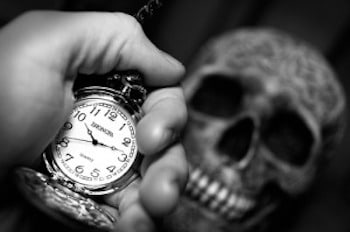 Defining Time of Death
Defining Time of Death
There are several times of death. Let me repeat that—there are several times of death. Time of death seems to be a simple and straight forward term that obviously means the exact time that the victim drew his last breath. Unfortunately, it’s not quite that simple.
There are actually three different times of death:
- The physiologic time of death, when the victim’s vital functions actually ceased.
- The legal time of death, the time recorded on the death certificate.
- The estimated time of death, the time the medical examiner estimates that death occurred.
It is important to note that the estimated time of death can vary greatly from the legal time of death and the physiologic time of death.
The only absolutely accurate determination of the time of death is the uncommon circumstance in which a person died with a physician or other skilled medical professional present. The doctor could make the determination and mark the time, and even this is assuming his watch or the clock on the wall was accurate. But that little inaccuracy aside, a death witnessed in this fashion is the only time that the three above times of death would correlate with one another.
Otherwise, it is impossible to determine the exact time of death. But what if someone witnessed the fatal blow or gunshot or what if the event was recorded on a timed surveillance camera, wouldn’t that accurately mark the time of death? The answer is a qualified yes. If the witnessed event led to immediate death, then the witness would have seen the actual death. If not, the witnessed event is simply the trauma that led to death but not the actual moment of death. People can survive massive and apparently lethal injuries for hours, even days or years.
But most deaths are not witnessed. Natural death may come during sleep, and accidental and suicidal deaths often occur when the victim is alone. In homicides, the perpetrator is typically the only witness and he rarely checks his watch, and even if he did, he’s not likely to talk about it. This means that when the medical examiner must determine the time of death he can only estimate the approximate time.
These times of death may differ by days, weeks, even months, if the body is not found until well after physiologic death has occurred. For example, if a serial killer killed a victim in July, but the body was not discovered until October, the physiologic death took place in July, but the legal death is marked as October, since that is when the corpse was discovered and the death was legally noted. The medical examiner estimated that the time of death could be July, or it could be June or August. It is only an estimate and many factors can conspire to confuse this determination. But, it is critically important for the medical examiner to be as accurate as possible.
The Importance of the Time of Death
An accurate estimation of the time of death can lead to discovering the identity of the assailant. In criminal cases, it can eliminate some suspects while focusing attention on others. For example, a husband says that he left for a business meeting at 2 P.M. and returned at 8 P.M. to find his wife dead. He says that he was home all morning and that she was alive and well when he left. If the ME determines the time of death was between 10 A.M. and noon, the husband has a great deal of explaining to do. On the other hand, if the estimation reveals that the death occurred between 4 and 6 P.M., and the husband has a reliable alibi for that time period, the investigation will move in a different direction.
Notice that in the above example the ME gave a range rather than an exact time for his estimated time of death. He didn’t say 4:30 P.M. but rather said between 4 and 6 P.M. Simply put, that’s the best he can do and that’s why it’s called the estimated time of death. It’s a best guess.
The time of death is not confined to criminal investigations; it can also come into play in civil situations. Insurance payments may depend upon whether the insured individual were alive at the time the policy went into effect or if he died before the policy expired. Even a single day can be important. Likewise, property inheritance can hinge on when the deceased actually died. Suppose two business partners die near the same time. Their contract may read that the company assets go the survivor if one of them dies. In this case, the heirs of the one that died last would own the company assets. Similarly, the dispersal of property under a will might be affected by which partner died first.
Determining Time of Death
Determining the time of death is both an art and a science and requires the Coroner and medical examiner use several techniques and observations to make his estimate. As a general rule, the sooner after death the body is examined, the more accurate this estimate will be.
Unfortunately, the changes that a body undergoes after death occur in widely variable ways and with unpredictable time frames. There is no single factor that will accurately indicate the time of physiological death. It is always a best guess. But when the principles are properly applied, the medical examiner can often estimate the physiologic time of death with some degree of accuracy.
To help with his estimation, the ME / Coroner utilizes various observations and tests, including:
Body temperature
Rigor mortis
Livor mortis (lividity)
Degree of putrefaction
Stomach contents
Corneal cloudiness
Vitreous potassium level
Insect activity
Scene markers

 Save big on online training using discount code spring17 Click on the savings banner to see current online course options.
Save big on online training using discount code spring17 Click on the savings banner to see current online course options.
Help us learn more about our community.
Take this short 10 question survey to help us tailor our podcast and training for you. 
 Death Investigation Training Academy has one goal; to provide the highest quality training using the most modern methods and technology. Death Investigation is all we do ! Many training agencies are well rounded and can fulfill the training needs in nearly every category of public policing and investigation. At DITA we concentrate on death investigation and everything surrounding those investigations. By becoming hyper-focused in this field we are better able to provide intense and specific training you and your investigators need.
Death Investigation Training Academy has one goal; to provide the highest quality training using the most modern methods and technology. Death Investigation is all we do ! Many training agencies are well rounded and can fulfill the training needs in nearly every category of public policing and investigation. At DITA we concentrate on death investigation and everything surrounding those investigations. By becoming hyper-focused in this field we are better able to provide intense and specific training you and your investigators need.

